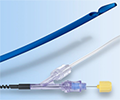Tag Archives: primary percutaneous coronary intervention

December 2018 Br J Cardiol 2018;25:152–6 doi:10.5837/bjc.2018.032
Thrombus aspiration in primary percutaneous coronary intervention: to use or not to use?
Telal Mudawi, Mohamed Wasfi, Darar Al-Khdair, Muath Al-Anbaei, Assem Fathi, Nikolay Lilyanov, Mohammed Elsayed, Ahmed Amin, Dalia Besada, Waleed Alenezi, Waleed Shabanh

Figure 1. A thrombus aspiration catheter Introduction The use of thrombus aspiration in primary percutaneous coronary intervention (PPCI) for ST-elevation myocardial infarction (STEMI) has been subject to intense scrutiny and debate over the last decade. Clinical trials have been undertaken, using varying randomisation methodologies, aiming to objectively quantify the impact of the practice, while several subsequent meta-analyses have been conducted with conflicting results. Uncertainty remains and no exclusive guidance has been internationally agreed regarding the definitive usefulness, or otherwise, of the practice. The use of thrombectomy

October 2015 Br J Cardiol 2015;22:157 doi:10.5837/bjc.2015.035 Online First
Pre-alert calls for primary PCI: a single-centre experience
Jennifer A Rossington, Stephen F Cole, Yasmin Zaidy, Michael S Cunnington, Richard M Oliver

Introduction Primary percutaneous coronary intervention (PPCI) is the preferred management for ST-elevation myocardial infarction (STEMI),1 and guidance committees have universally adopted this strategy as the ‘gold standard’ of care.2-4 National Institute for Health and Care Excellence (NICE) guidelines mandate that PPCI is not only accessible to the entire population of the UK, but also that this is delivered in a timely fashion.4 Therefore, the early identification of appropriate STEMI patients for PPCI is essential, but this can be complicated due to the volume of patients, inadequate training and experience of frontline emergency car
June 2013 Br J Cardiol 2013;20:65 doi:10.5837/bjc.2013.17 Online First
Prognostic value of renal function in STEMI patients treated with primary PCI: ANIN Registry
Magdalena Polanska-Skrzypczyk, Maciej Karcz, Pawel Bekta, Cezary Kepka, Jakub Przyluski, Mariusz Kruk, Ewa Ksiezycka, Andrzej Ciszewski, Witold Ruzyllo, Adam Witkowski

Introduction Myocardial infarction with persistent ST-elevation (STEMI) continues to be a major public health problem. In a recent report, the incidence of hospital admissions for STEMI in Europe varied between 44 and 142 per 100,000 inhabitants per year, and in-hospital mortality reached 13.5%.1 More than 30% of STEMI patients have chronic kidney disease (CKD).2 On the other hand, half of deaths in advanced CKD patients are of cardiovascular causes with myocardial infarction (MI) being the most frequent event.3 Patients with CKD are routinely excluded from cardiovascular clinical trials, and certain medications and treatment modalities are l

March 2013 Br J Cardiol 2013;20:32–7 doi:10.5837/bjc.2013.007
Primary angioplasty for acute STEMI in secondary care: feasibility, outcomes and potential advantages
Andrew Whittaker, Lee Rowell, Olayiwola Olatawura, Petra Poliacikova, Jason Glover, Carl I Brookes, Andrew J Bishop

Introduction On inference from a range of randomised clinical trials, timely primary percutaneous coronary intervention (PPCI) has become the optimal strategy for the treatment of ST-segment elevation myocardial infarction (STEMI).1-8 Despite the logistic complexity and potential for delay compared with fibrinolytic treatment, the standard outcomes of safety and effectiveness of PPCI are superior to fibrinolysis unless the time delay is substantial.9-12 These data have led to the decision that, not only should PPCI be the treatment of choice for STEMI in England, it must be available 24 hours per day, seven days per week.13 This generates log
February 2013 Online First
British Society of Heart Failure Young Investigators’ Award

Multipolar left ventricular pacing to optimise acute haemodynamic response to cardiac resynchronisation therapy SY Ahsan (presenting author), B Sabberwal, C Hayward, P Lambiase, M Thomas, GG Babu, S Aggarwal, MD Lowe, AWC Chow The Heart Hospital, Institute of Cardiovascular Science, University College Hospitals NHS Foundation Trust, London Purpose: Cardiac resynchronisation therapy (CRT) reduces morbidity and mortality in a sub-group of patients with heart failure, though up to 30% of patients have no benefit. CRT patients are heterogeneous and an individualised approach to CRT may be needed to increase response rate. We evaluated the impact

February 2010 Br J Cardiol 2010;17:25–7
Collaboration of district general hospitals with a physician-to-patient approach can deliver a 24-hour primary angioplasty service with favourable door-to-balloon times
Poi Keong Kong, Derek Connolly, Rajai Ahmad

Introduction Prompt primary percutaneous coronary intervention (PPCI) is the preferred treatment for patients presenting with ST-segment elevation myocardial infarction (STEMI).1 Clinical outcomes are better with higher procedural volume2 and the intuitive deduction is that PPCIs should be performed by high-volume, usually large, tertiary hospitals. Provision of 24-hour PPCIs by collaboration of other hospitals such as district general hospitals (DGHs) has not been studied in detail. Sandwell General Hospital is an acute DGH that provides PPCI service without on-site cardiac surgical facilities to a catchment population of 250,000. The servic

